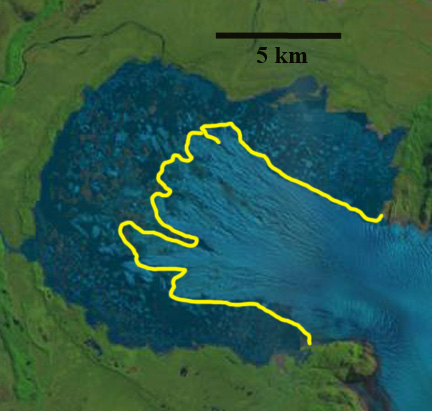February 15, 2016
San Quintin Glacier, Chile terminus disintegration 1987-2015
Posted by Mauri Pelto
Landsat comparison of San Quintin Glacier in 1987 and 2015: red arrow indicates 1987 terminus location, yellow arrow indicates 2015 terminus location of the three main termini, and the purple arrow indicates upglacier thinning.
San Quintin is the largest glacier of the NPI at 790 km2 in 2001 (Rivera et al, 2007). The glacier extends 50 km from the ice divide in the center of the ice cap. The peak velocity is 1100 m/year near the ELA (Rivera et al 2007), declining below 350 m/year in the terminus region. The velocity at the terminus has increased from 1987 to 2014 as the glacier has retreated into the proglacial lake (Mouginot and Rignot, 2015). The high velocity zone extends more than 40 km inland an even greater distance than at San Rafael (Mouginot and Rignot, 2015). Thinning rates in the ablation zone of the glacier are 2.3 m/year (Willis et al, 2012). The glacier has a low slope rising 700 m in the first 22 km. The low slope, broad piedmont lobe and many distributary terminus lobes is like the Brady Glacier, Alaska.
Davies and Glasser (2012) note that San Quintin Glacier terminated largely on land until 1991. The glacier has lost 15 % of its area in the last century (Davies and Glasser, 2012). The glacier has a main terminus and many subsidiary termini. In 1987 it is a piedmont lobe with evident minimal marginal proglacial lake development beginning. There is limited lake development at the main southern and northern terminus Point C and B respectively. Harrison et al (2001) observed that in 1993 the glacier terminus was advancing strongly into vegetated ground, while from 1996 to May 2000 the glacier underwent a transition between advance and retreat. The high rates of thinning are leading to the retreat not just of main terminus but the distributary terminus areas extending north and south into lake basins from the main glacier. From 1987 to 2015 the main terminus retreated 2200 m, almost all after 2000, largely through a disintegration of the terminus tongue in a proglacial lake. Extensive rifting of the terminus lobe in 2013 and 2015 is still apparent in imagery below, indicating this rapid area loss is not finished. The main lake, Point A, had an area of 23.8 square kilometers in 2011 (Loriaux and Cassasa, 2013) . The lake at Point B developing on the north side of the glacier, due to a 3500 m retreat, is now over 8 square kilometers. The southern terminus at Point C, has a narrow fringing lake and a retreat of 1100 meters from 1987-2015. The retreat here follows the pattern of Fraenkel Glacier, Acodado Glacier and Steffen Glacier to the south.
Digital Globe image of San Quintin Glacier in 2011.
2013 Google Earth image, with the large rifts indicating glacier weakness noted with blue arrows.
2015 Landsat image, yellow line indicates terminus. Note the tongue is surrounded on three sides by water.






 Dean of Academic Affairs at Nichols College and Professor of Environmental Science at Nichols College in Massachusetts since 1989. Glaciologist directing the North Cascade Glacier Climate Project since 1984. This project monitors the mass balance and behavior of more glaciers than any other in North America.
Dean of Academic Affairs at Nichols College and Professor of Environmental Science at Nichols College in Massachusetts since 1989. Glaciologist directing the North Cascade Glacier Climate Project since 1984. This project monitors the mass balance and behavior of more glaciers than any other in North America.
[…] those of the Northern and Southern Patagonia ice fields,” Pelto said. For comparison, the San Quintin and Steffen glaciers of the Northern Patagonia ice field lost 7 and 12 percent of their lengths, […]
San Quintin glacier displacement map from Sentinel-2 imagery
http://www.cesbio.ups-tlse.fr/multitemp/?p=9001